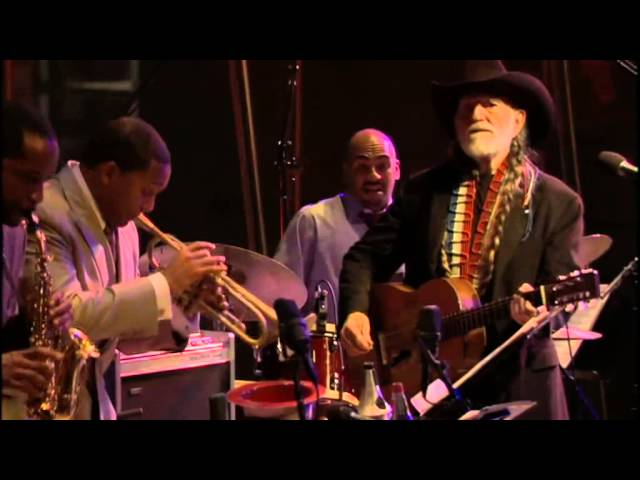Willie Nelson and Wynton Marsalis made for a simpatico pairing when they began making music together in 2007. The trumpeter welcomed the country music legend to Jazz at Lincoln Center, (in Bambino terms, The House that Wynton Built), for an intensive week of rehearsals and performances that Blue Note released as Two Men With the Blues. The album knocked me out when it arrived six years ago, but I wasn’t aware till this morning that a lavishly-produced film was also made of the concert. Marsalis & Co. (Walter Blanding, tenor saxophone; Dan Nimmer, piano; Carlos Henriquez, bass; and Ali Jackson, Jr., drums) inspired some of Nelson’s finest late career work in a program that ranges from classic blues to swing to country to gospel. Duke Ellington might have called the encounter, “beyond category.” Willie says, “Labels were invented to sell music…Some music encompasses it all. And that’s pretty much what I like to play.” He says the experience made for “one of the red-letter days, red-letter weeks, of my life.”

Call him progressive country or outlaw, there’s always been a blue tinge to Willie’s sound, and here it’s in full force. Along with his 2002 release, Milk Cow Blues, this makes a strong case for the Abbott, Texas native as a consummate blues singer. The set includes his originals, “Night Life” and “Rainy Day Blues,” and the blues classics, “Bright Lights, Big City,” “Ain’t Nobody’s Business,” “Basin Street Blues,” and “Caldonia;” the standards “Georgia on My Mind” and “Stardust;” and Merle Travis’s yarn about the educated fool, “That’s All.” The film offers three additional cuts that didn’t make the CD: “Don’t Get Around Much Anymore,” “Sweet Georgia Brown,” and “Down by the Riverside.”
Comments by Wynton and Willie are interspersed with concert and rehearsal material throughout the production. Nelson generally lets his lyrics do the talking, but he enthuses over his longtime harmonica player Mickey Rafael. “He stayed with those guys,” Willie says of Rafael, who reflects the influence of Paul Butterfield and Nashville session man, Charlie McCoy. “They were in awe of what he did, but I wasn’t surprised to see him jump in there and hold his own.” Marsalis says, “Mickey’s the train whistle.” As he mimics the blues harp’s “wah wah” effects, he says “We like to call [each other on our] horns.”
In describing why their seemingly disparate approaches work so well, Wynton makes casual reference to a thesis he’s been propounding and courting controversy with for the entirety of his career. Following the performance of “Night Life,” he says, “Blues runs through everything that’s good in American music.” I tend to agree, but that’s an area of dispute with the numbers of jazz players and improvisers who find blues tonality and form confining and prescriptive.
The concert was filmed in JALC’s Allen Room at Frederick P. Rose Hall on January 12 and 13, 2007. Two years later, Wynton and Willie reunited and were joined by Norah Jones to pay tribute to Ray Charles. We’ll hear selections from both in Monday night’s Jazz a la Mode. Today is Wynton Marsalis’s 53rd birthday.



